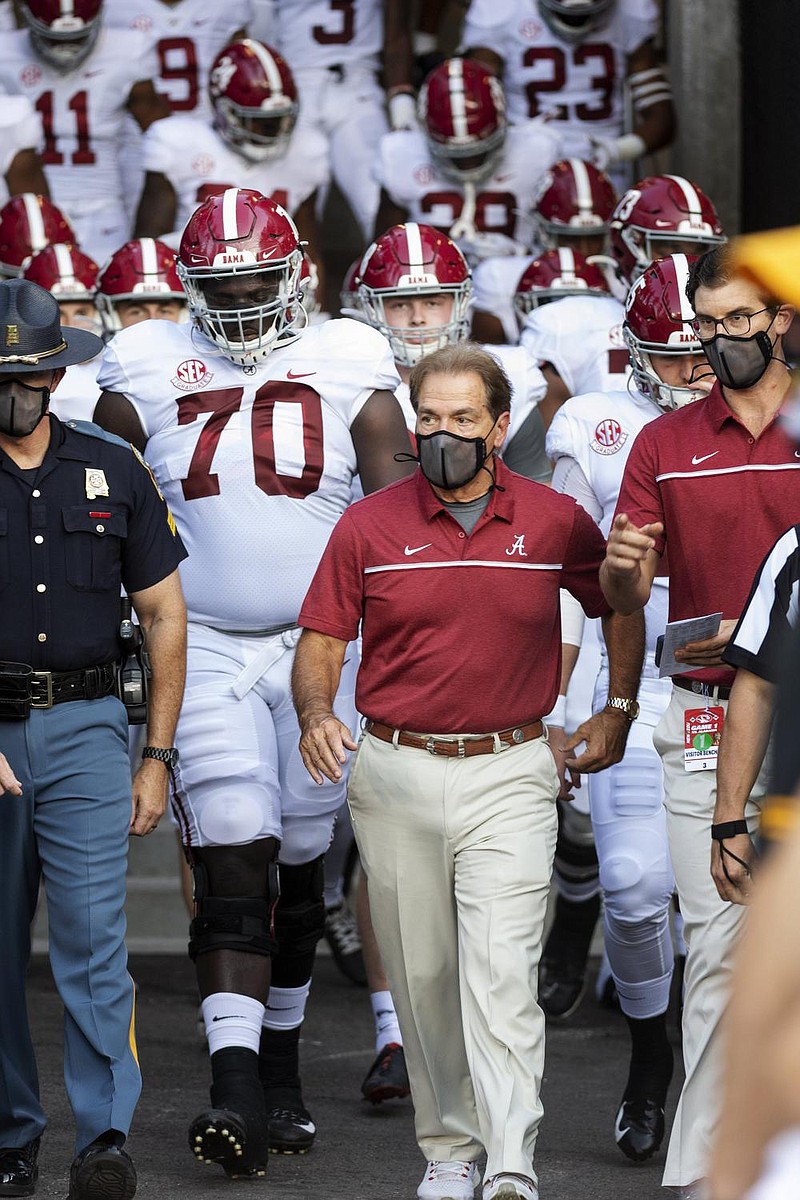A private jet, the crimson "A" of the University of Alabama painted on its tail, lifted off from Tuscaloosa, Ala., around daybreak Saturday with extraordinary cargo: cellular debris collected from the nose of Nick Saban.
Three days earlier, Saban had announced that he had tested positive for covid-19. Now, still in isolation hours before second-ranked Alabama was to play third-ranked Georgia, Saban knew the specimen aboard the plane was his diagnostic lifeline to the sideline. If a laboratory in Mobile, Ala., reported that the sample was negative for the virus, Saban would be allowed to leave isolation a week early and coach in the prime-time game.
Hours after a final negative result -- and with no small help from a rule change that SEC leaders approved six days before the positive test -- millions of people watched on TV as Saban led the Crimson Tide to a 41-24 victory.
The episode underscored two aspects of the response to the virus: Even the most rigorous tests -- in this case a polymerase chain reaction, or PCR, widely considered the gold standard of infectious disease diagnostics -- can falter. And, more than seven months into the nation's coronavirus crisis, access to testing remains inconsistent, except among America's elite.
While tests remain scarce in many communities -- and too expensive to allow some leagues and universities to compete this fall -- they have more than once helped break a prominent figure out of isolation.
"It's a reminder of the stark disparity between the haves and have-nots," said Dr. Ashish Jha, dean of the Brown University School of Public Health.
As the pandemic has strained athletic finances on campuses nationwide, it has put Alabama's resources and football obsession on greater display. The SEC, for instance, requires its football teams to be tested at least three times a week under a protocol that hinges almost entirely on PCR testing, one of the most accurate and expensive techniques on the market. But Alabama opted for daily screenings of its football players and coaches.
On Oct. 14, Saban learned that one of his PCR tests -- which had been processed at a local laboratory -- had come back positive. He headed home, oversaw practice via Zoom and held a news conference from afar, saying he had been "very surprised" by the result.
With the case count around the football complex low -- only Saban and the university's athletic director tested positive, according to Alabama -- people in Tuscaloosa and elsewhere wondered whether that Wednesday test was flawed.
PCR-based tests for the virus hunt for specific stretches of genetic material, which they can copy repeatedly until their targets reach detectable levels. That makes it easy to identify the virus and difficult to mistake something else for the pathogen. But as with any procedure, mistakes are possible.
Differences in the way the test samples are handled, processed and analyzed can upend results. Pressure to speed up the turnaround time for results could also make it harder to keep machines running in tiptop shape, or to ensure consistency from test to test.
Alabama swiftly began its investigation into Saban's positive result. There were medical reasons to try to confirm the result, but urgent football ones, too.
Less than a week before Saban said he had tested positive, the SEC's chancellors and presidents had approved an update to the league's medical protocols. Under the new policy, an asymptomatic person such as Saban who tested positive for the virus could take another PCR test within 24 hours. If that test yielded a negative result, the person could take two more PCR tests. If all three results were negative, the player, coach or staff member could return to athletics.
It is unusual to administer a follow-up screening after someone tests positive by PCR, and the Centers for Disease Control and Prevention recommends that such a result send an asymptomatic person into isolation for 10 days.
But in the weeks before Saban's test, the conference had an experience with a false positive involving a soccer player at Texas A&M, Sports Illustrated reported. And the league's medical experts had also begun to worry about the potential public health effects of an unchecked false positive: a person's being dropped from routine testing and perhaps acquiring a sense of invincibility that they could no longer contract the virus -- potential fodder for an outbreak, should that person be exposed.
"The repercussions for that false positive aren't just for that athlete," said Dr. Catherine O'Neal, an infectious disease specialist at LSU and a member of the SEC's medical task force. "It puts the entire team at risk."
Despite the slight variances of the SEC's new protocol from others' guidelines, outside experts said that a lone positive result among so many negative PCR tests was almost certainly inaccurate.
Rules made clear that Saban could not coach if he had the virus. If Alabama wanted Saban in charge against Georgia, the new approach was its only option. And even if the plan worked, it would not be clear until sometime Saturday.
Less than 24 hours after the positive result, Saban took the first of the three SEC-sanctioned tests he would need to pass to exit isolation.
His first formal follow-up tests, conducted around 7 a.m. Thursday and Friday, showed negative results, as did two other PCR tests that Alabama ordered. Alabama announced the first SEC test's results, and ESPN reported the findings of the second as it broadcast from Alabama's stadium Saturday morning.
Driving the last specimen to Mobile would have taken more than three hours on game day, potentially stripping Saban of precious time with his team. So Alabama athletics turned to its speediest option: its jet.
Before noon in Tuscaloosa, with the Crimson Tide Foundation's plane already long gone from Mobile, the decisive report arrived.
Saban headed to work.
